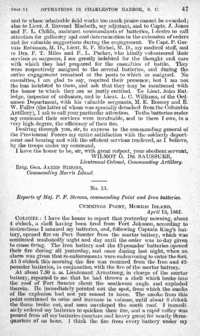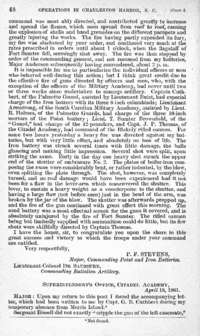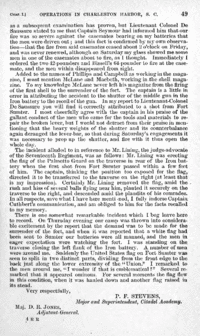At the outbreak of the war, Peter Stevens was a Major in the Provisional Confederate States Army
These dispatches were compiled with primary source materials from The War of the Rebellion: A Compilation of Official Records of the Union and Confederate Armies (Chapter 1)
|
CONTENTS
This feature is not yet available. Check back soon for updates!
(CS LtC) Wilmot de Saussure
- At the outbreak of the war, Wilmot de Saussure was a Lieutenant Colonel in the Provisional Confederate States Army
| To Stevens:
|
From Stevens:
|
|
|
| April 13, 1861 - Major Peter Stevens to Lieutenant Colonel Wilmot de Saussure
|
 Click for full-sized scanned image  Click for full-sized scanned image Reports of Major P.F. Stevens, commanding Point and Iron batteries
CUMMINGS POINT, MORRIS ISLAND,
April 13, 1861.
COLONEL: I have the honor to report that yesterday morning, about 4 o'clock, a shell having been fired from Fort Johnson, according to instructions I manned my batteries, and, following Captain King's battery, opened fire on Fort Sumter from the mortar battery, which was continued unabatedly night and day until the order was to-day given to cease firing. The Iron battery and the 42-pounder batteries opened their fire during all yesterday, and once during last night, when an alarm was given that re-enforcements were endeavoring to enter the fort. At 5 o'clock this morning the fire was resumed from the Iron and 42-pounder batteries, in conjunction with the fire of the mortar battery.
At about 7.30 a.m. Lieutenant Armstrong, in charge of the mortar battery, reported to me that he had thrown a shell which broke into the roof of Fort Sumter about the southwest angle and exploded therein. He immediately pointed out the post, from which the smoke of the explosion had not yet ceased to issue. The smoke from this point continued to arise and increase in volume, until about 8 o'clock the flame broke out, and soon enveloped the south roof. I immediately ordered my batteries to quicken their fire, and a rapid volley was poured from all my batteries (mortars and heavy guns) for nearly three-quarters of an hour. I think the fire from every battery under my command was most ably directed, and contributed greatly to increase and spread the flames, which soon spread from roof to roof, causing the explosion of shells and hand grenades on the different parapets and greatly injuring the works. The fire having partly expended its fury, my fire was slackened by your order, and continued very much at the rates prescribed in orders until about 1 o'clock, when the flagstaff of Fort Sumter fell, seemingly shot away. The fire was then stopped by order of the commanding general, and not resumed from my batteries, Major Anderson subsequently having surrendered, about 2 p.m.
It is impossible for me to particularize the individual officers or men who behaved well during this action; but I think great credit due to the effective fire of guns directed by officers and men, who, with the exception of the officers of the Military Academy, had never until two or three weeks since undertaken to manage artillery. Captain Cuthbert, of the Palmetto Guard, assisted by Lieutenant Buist, had especial charge of the Iron battery with its three 8-inch columbiads; Lieutenant Armstrong, of the South Carolina Military Academy, assisted by Lieutenant R. Holmes, of the Palmetto Guards, had charge of the three 10-inch mortars of the Point battery; Lieutenant T. Sumter Brownfield, of the "Guard," had charge of the 42-pounders, and Captain J. P. Thomas, of the Citadel Academy, had command of the Blakely rifled cannon. For some two hours yesterday a heavy fire was directed against my batteries, but with very little effect, and absolutely no loss of life. The Iron battery was struck several times with little damage, the balls glancing and making little impression. Several shot were split, upon striking the same. Early in the day one heavy shot struck the upper end of the shutter of embrasure Numbers 2. The plates of boiler-iron composing the same were considerably bent, or rather indented, by the blow, even splitting the plate through. The shot, however, was completely turned, and no real damage would have been experienced had it not been for a flaw in the lever-arm which maneuvered the shutter. This lever, to sustain a heavy weight as a counterpoise to the shutter, and having a large flaw (not before seen) just in the bend of the arm, was broken by the jar of the blow. The shutter was afterwards propped up, and the fire of the gun continued with great effect this morning. The sand battery was a most effectual screen for the guns it covered, and is absolutely uninjured by the fire of Fort Sumter. The rifled cannon being but limitedly supplied with ammunition could do little, but its few shots were skillfully directed by Captain Thomas.
I have the honor, sir, to congratulate you upon the share in this great success and victory to which the troops under your command are entitled.
Very respectfully,
P.F. STEVENS,
Major, Commanding Point and Iron Batteries.
Lieutenant-Colonel DE SAUSSURE,
Commanding Battalion Artillery.
(To view this page in its Source Category, click HERE for Part 1 and HERE for Part 2)
|
|
(CS AAG) David Jones
- At the outbreak of the war, David Jones was a Major and Assistant Adjutant General in the Provisional Confederate States Army. He was quickly promoted to full Adjutant General
| To Stevens:
|
From Stevens:
|
|
|
| April 18, 1861 - Major Peter Stevens to Adjutant General David Jones
|
 Click for full-sized scanned image  Click for full-sized scanned image Reports of Major P.F. Stevens, commanding Point and Iron batteries
SUPERINTENDENT'S OFFICE, CITADEL ACADEMY,
April 18, 1861.
MAJOR: Upon my return to this post I found the accompanying letter, which had been written to me by Captain G.B. Cuthbert during my temporary absence from Morris Island.*
Sergeant Bissell did not exactly "cripple the gun of the left casemate," as a subsequent examination has proven, but Lieutenant Colonel De Saussure stated to me that Captain Seymour had informed him that our fire was so severe against the casemates bearing on my batteries that the men were driven out; and this fact is confirmed by my own observation-that the fire from said casemates ceased about 2 o'clock on Friday, and was never renewed, although on Saturday my glass showed me some men in one of the casemates about to fire, as I thought. Immediately I ordered the two 42-pounders and Bissell's 64-pounder to fire at the casemate, and the men within disappeared from sight.
Added to the names of Phillips and Campbell as working in the magazine, I must mention McLane and Macbeth, working in the shell magazine. To my knowledge McLane never left his magazine from the firing of the first shell to the surrender of the fort. The captain is a little in error in attributing the accident to the shutter of the middle gun in the Iron battery to the recoil of the gun. In my report to Lieutenant-Colonel De Saussure you will find it correctly attributed to a shot from Fort Sumter. I most cheerfully agree with the captain in his praise of the gallant conduct of the men who came for the tools and materials to repair the broken lever, but I would not detract from their praise in mentioning that the heavy weights of the shutter and its counterbalance again deranged the lever-bar, so that during Saturday's engagements it was necessary to prop up the shutter, and fire with it thus open the whole day.
The incident alluded to in reference to Mr. Lining, the judge-advocate of the Seventeenth Regiment, was as follows: Mr. Lining was erecting the flag of the Palmetto Guard on the traverse in rear of the Iron battery when the first shot from Fort Sumter passed within a few feet of him. The captain, thinking the position too exposed for the flag, directed it to be transferred to the traverse on the right (at least that is my impression). Certainly Mr. Lining removed the flag, amid the rush and hiss of several balls flying near him, planted it securely on the traverse to the right, and descended amid the plaudits of his comrades. In all respects, save what I have here mentioned, I fully indorse Captain Cuthbert's communication, and am obliged to him for the facts recalled to my memory.
There is one somewhat remarkable incident which I beg leave here to record. On Thursday evening our camp was thrown into considerable excitement by the report that the demand was to be made for the surrender of the fort, and when it was reported that a white flag had been sent to Sumter our batteries were all manned, and the men in eager expectation were watching the fort. I was standing on the traverse closing the left flank of the Iron battery. A number of men were around me. Suddenly the United States flag on Fort Sumter was seen to split in two distinct parts, dividing from the front edge to the back just along the lower extremity of the "Union." I remarked to the men around me, "I wonder if that is emblematical?" Several remarked that it appeared ominous. For several moments the flag flew in this condition, when it was hauled down and another flag raised in its stead.
Very respectfully,
P.F. STEVENS,
Major and Superintendent, Citadel Academy.
Major D.R. JONES,
Adjutant-General.
* Not found.
(To view this page in its Source Category, click HERE for Part 1 and HERE for Part 2)
|
|
|


